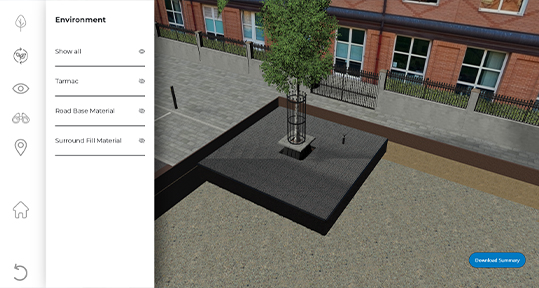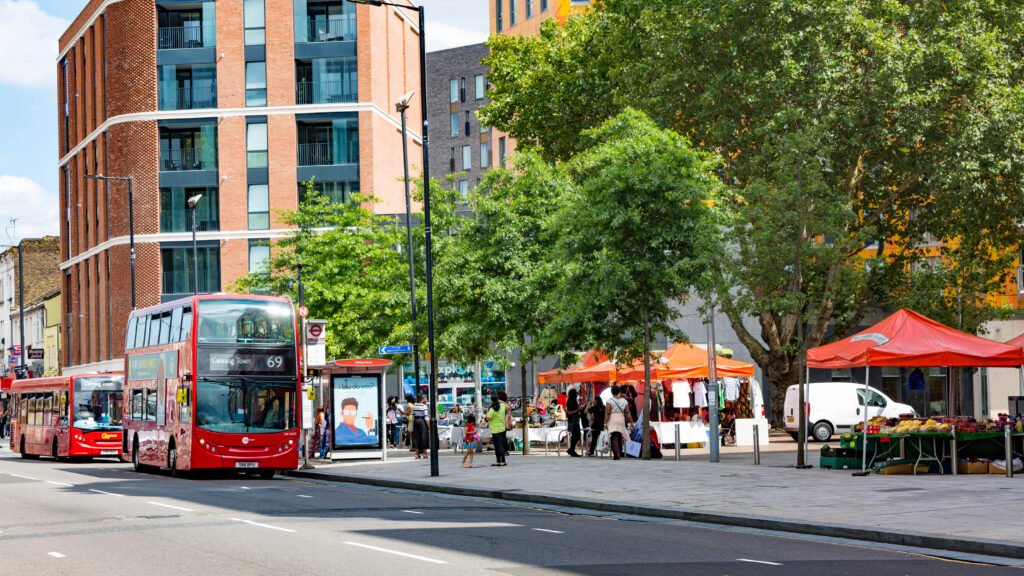This case study is about the stars of St Louis’ beloved Muny Theatre. But these stars never leave the stage. The trees that accent The Muny stage have been an iconic part of its heritage since it opened in 1917, and when redevelopment discussions took place over a hundred years later, there was no doubt that trees needed to be a part of its future as well.
After The Muny’s centennial celebration in 2018, the old stage was demolished and a state-of-the-art replacement reclaimed the theatres’ focal point. As part of the restoration, the removal of the existing oak trees that lined the back of the stage, estimated at around 300 years old, was inevitable.
“Replacing the trees was part of the plan all along,”explained Sean Smith, Director of Operations at The Muny.
After three years of planning for the new tree component, maintaining the almost park-like setting that provided the theatres’ ambience was a primary goal for the project.
From the very first project meeting, all the decision-makers – the president, the stage managers, the landscape architect, the arborist – were sitting down at the table going through every possible scenario on what could be done to maintain the atmosphere the old trees provided.
“All hands were on deck saying that if we’re losing those trees, we have to do everything possible to make sure we recreate that aesthetic and critical backdrop that everyone has come to love and appreciate,” explained the project Arborist, Meridith McAvoy Perkins.
But it wasn’t just about replacing the heritage trees, it was about continuing their legacy. This was accomplished by grafting one of the oak old trees into the new ones that replaced them.
“When you graft a tree, you take pieces of that tree from what’s called the scion wood, which is the new growth. You cut those and splice them onto an existing root of the new tree,” explained Paul Toenjes, Landscape Architect at SWT Design. “
The idea being that you have an exact genetic copy – it is essentially the same tree because it’s still the growth of that tree.”
“When we were looking at replacing the trees and reforesting the stage, we wanted to make sure that the new trees had the absolute best chance of survival,” said Denny Reagan, The Muny’s CEO.
“Things like the roots growing into the concrete and the fact that the trees weren’t getting adequate oxygen and rainfall to their roots, caused a lot of problems with the old trees,” – Ted Spaid, Founding Partner of SWT Design explained the contributing factors to the removal of the old trees and the key considerations for the design of the new ones.
GreenBlue Urban’s RootSpace ArborSystem provided this assurance. A designated rooting area that provided adequate soil volume for the long-term growth of the trees, while protecting the surrounding infrastructure. It also ensures that water and oxygen can access the soil volume to keep the roots healthy.
The President and CEO of The Muny said in an interview that there were two mandates the design team were given for the redevelopment of The Muny. “One was to make the stage absolutely state-of-the-art. The second mandate was to make sure the look and feel of The Muny weren’t lost. And what we meant by that was the tree canopy, which is such an important part of what The Muny has been and what we want it to continue to be moving forward.”
That’s why the landscape architects at SWT Design turned to GreenBlue Urban to make use of RootSpace ArborSystem, the original urban tree planting system. After inventing the world’s first soil cell in 2000, GreenBlue Urban has since helped trees like the ones at The Muny thrive in even the harshest built environments.
RootSpace soil cells provided high volumes of healthy uncompacted soil for the trees, while the RootRain Irrigation/Aeration System allows water and oxygen to access the tree roots – bringing The Muny CEO’s desire of having the absolute best chance of tree survival to realization.
“A staple since our humble beginning, the iconic tree canopy has returned home,” The Muny wrote in a Facebook post debuting its reopening. The post continued to say, “With pride, we are once again the theatre between the mighty oaks.”
Watch this video to learn more about the important role that trees played on this project.
Project
Location
Contractor
Landscape Architect
This case study is about the stars of St Louis’ beloved Muny Theatre. But these stars never leave the stage. The trees that accent The Muny stage have been an iconic part of its heritage since it opened in 1917, and when redevelopment discussions took place over a hundred years later, there was no doubt that trees needed to be a part of its future as well.
After The Muny’s centennial celebration in 2018, the old stage was demolished and a state-of-the-art replacement reclaimed the theatres’ focal point. As part of the restoration, the removal of the existing oak trees that lined the back of the stage, estimated at around 300 years old, was inevitable.
“Replacing the trees was part of the plan all along,”explained Sean Smith, Director of Operations at The Muny.
After three years of planning for the new tree component, maintaining the almost park-like setting that provided the theatres’ ambience was a primary goal for the project.
From the very first project meeting, all the decision-makers – the president, the stage managers, the landscape architect, the arborist – were sitting down at the table going through every possible scenario on what could be done to maintain the atmosphere the old trees provided.
“All hands were on deck saying that if we’re losing those trees, we have to do everything possible to make sure we recreate that aesthetic and critical backdrop that everyone has come to love and appreciate,” explained the project Arborist, Meridith McAvoy Perkins.
But it wasn’t just about replacing the heritage trees, it was about continuing their legacy. This was accomplished by grafting one of the oak old trees into the new ones that replaced them.
“When you graft a tree, you take pieces of that tree from what’s called the scion wood, which is the new growth. You cut those and splice them onto an existing root of the new tree,” explained Paul Toenjes, Landscape Architect at SWT Design. “
The idea being that you have an exact genetic copy – it is essentially the same tree because it’s still the growth of that tree.”
“When we were looking at replacing the trees and reforesting the stage, we wanted to make sure that the new trees had the absolute best chance of survival,” said Denny Reagan, The Muny’s CEO.
“Things like the roots growing into the concrete and the fact that the trees weren’t getting adequate oxygen and rainfall to their roots, caused a lot of problems with the old trees,” – Ted Spaid, Founding Partner of SWT Design explained the contributing factors to the removal of the old trees and the key considerations for the design of the new ones.
GreenBlue Urban’s RootSpace ArborSystem provided this assurance. A designated rooting area that provided adequate soil volume for the long-term growth of the trees, while protecting the surrounding infrastructure. It also ensures that water and oxygen can access the soil volume to keep the roots healthy.
The President and CEO of The Muny said in an interview that there were two mandates the design team were given for the redevelopment of The Muny. “One was to make the stage absolutely state-of-the-art. The second mandate was to make sure the look and feel of The Muny weren’t lost. And what we meant by that was the tree canopy, which is such an important part of what The Muny has been and what we want it to continue to be moving forward.”
That’s why the landscape architects at SWT Design turned to GreenBlue Urban to make use of RootSpace ArborSystem, the original urban tree planting system. After inventing the world’s first soil cell in 2000, GreenBlue Urban has since helped trees like the ones at The Muny thrive in even the harshest built environments.
RootSpace soil cells provided high volumes of healthy uncompacted soil for the trees, while the RootRain Irrigation/Aeration System allows water and oxygen to access the tree roots – bringing The Muny CEO’s desire of having the absolute best chance of tree survival to realization.
“A staple since our humble beginning, the iconic tree canopy has returned home,” The Muny wrote in a Facebook post debuting its reopening. The post continued to say, “With pride, we are once again the theatre between the mighty oaks.”
Watch this video to learn more about the important role that trees played on this project.
Project
Location
Contractor
Landscape Architect
Project
Location
Contractor
Landscape Architect







